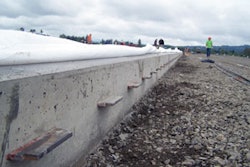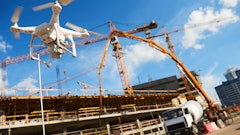
Freshly placed concrete in wall and column forms behaves like a liquid producing hydrostatic pressure that acts laterally on the vertical faces of the formwork. However, due to concrete stiffening, the hydrostatic pressure is only temporary. As the fresh concrete changes from a liquid into a quasi-solid, the lateral pressure diminishes.
Full fluid pressure
Depending on the placement rate and setting characteristics of the concrete, the lateral pressure can be equal to a full liquid head, also referred to as full fluid pressure. To compute the full fluid pressure, multiply the concrete height by the unit weight of the fresh concrete [150 pounds per cubic foot (pcf) for standard weight concrete] as shown in Example 1.
For a concrete height of 10 feet, the full fluid pressure is equal to 1,500 pounds per square foot (psf). Like diving into and swimming to the bottom of a swimming pool, the pressure increases with depth so the maximum pressure or full fluid pressure occurs at the bottom of the formwork.
Full fluid pressure may occur when the concrete placement rate is fast and the rate of stiffening is slow or delayed due to chemical retarders, blended cements and supplementary cementitious materials, or cold weather conditions. This is especially true for columns and walls that can be filled rapidly before stiffening of the concrete occurs.

Modified hydrostatic pressure
If placement rates are not too fast and concrete stiffening is not too slow, concrete at the bottom of the form starts to stiffen before the form is full of fresh concrete. When this occurs, hydrostatic pressure at the bottom of the form drops off to less than full fluid pressure. This "modified hydrostatic pressure" is influenced by the weight of the fresh concrete, rate of concrete placement, temperature of the concrete mixture, types of admixtures, cement type and amount of supplementary cementitious materials in the concrete. Of course, lateral pressure is strongly influenced by the type, extent and depth of concrete vibration used to consolidate the fresh concrete. Even partially hardened or quasi-solid concrete can be returned to a liquid state producing a full fluid pressure when vibrated so be sure to follow guidelines for depth of consolidation.
ACI 347-04 "Guide to Formwork for Concrete" lists three modified hydrostatic pressure equations:
- pmax=CwCc [150+9000R/T] for columns.
- pmax=CwCc [150+9000R/T] for walls with a rate of placement of less than 7 feet per hour and placement height not exceeding 14 feet.
- pmax=CwCc [150+43,400T+2800R/T] for walls with a placement rate less than 7 feet per hour where placement height exceeds 14 feet and for all walls with a placement rate of 7 to 15 feet per hour.
Where:
- pmax=maximum lateral pressure (psf)
- R=rate of placement (feet per hour) [defined as average rate of rise of the concrete in the form]
- T=temperature of the concrete during placement (°F)
- Cw=unit weight coefficient (for 140 to 150 pcf concrete, Cw=1.0)
- Cc=chemistry coefficient (see Table 1)

The ACI 347-04 equations are based on concrete having a slump of 7 inches or less and placed with a normal vibration to a depth of 4 feet or less. Regardless of the pmax calculated from the three equations above, ACI 347-04 says not to use pressures less than 600Cw (psf) or greater than wh (psf), or the full fluid pressure. Setting an absolute minimum formwork pressure helps ensure safety. Using the previous wall example with a rate of placement of 4 feet per hour and a concrete temperature of 60° F, ACI's modified hydrostatic pressure as shown below in Example 2 yields a maximum lateral pressure of 750 psf or one-half of the full fluid pressure as shown in Example 1.

As shown in Example 2, the lateral pressure was significantly reduced due to concrete stiffening in the bottom 5 feet of the form. If the rate of concrete placement or the concrete temperature changes so will the lateral pressure on the vertical faces of the formwork. Many references have created tables based on the ACI 347-04 equations for computing lateral pressure on column and wall forms so computing the modified hydrostatic pressure is as easy as sliding your finger along the columns and rows to read off the correct pressure.
Allowable formwork pressure
Column and wall forms should never be exposed to lateral pressures exceeding the maximum allowable pressure. Otherwise, the risk of excessive form deflections, bulges and even "blowouts" may significantly increase. While not life threatening, excessive formwork deflections, bulges, and bent and damaged formwork are also costly and may delay construction schedules, especially if columns or walls are out-of-tolerance and require repairs.
Manufacturers' literature and formwork drawings should always show the allowable formwork pressure. Using the allowable formwork pressure and the ACI 347-04 pressure equations, you can compute the maximum rate of concrete placement so you do not fill the form too fast and exceed the maximum pressure rating for the formwork. To simplify this calculation, many references and formwork manufacturers provide allowable placement rate tables for different allowable formwork pressures as shown in Table 2 for a typical snap-tie, plywood, single or double wale system.
If the concrete placing temperature is 60° F and the coefficients for unit weight (Cw) and chemistry (Cc) are 1.0, then the maximum rate of placement is 3 feet per hour. If this rate is exceeded, then the lateral pressure will exceed the allowable 600 psf formwork pressure. As shown in Example 2, a placement rate of 4 feet per hour produced a lateral pressure of 750 psf or 150 psf larger than the allowable. As shown in Example 1, if the wall form was filled with concrete faster than the concrete could start to stiffen, the maximum lateral pressure would be 1,500 psf or 2.5 times larger than the allowable pressure.
You can avoid the pitfalls of too much pressure through careful planning of concrete placement rates. Be sure you are aware of allowable formwork pressures and placement rates or you run the risk of exposing your formwork to too much pressure and expensive consequences like blowouts, excessive deflections, bulges, and bent and damaged formwork.
Reference:
ACI 347-04 "Guide to Formwork for Concrete," American Concrete Institute, 38800 Country Club Dr., Farmington Hills, Mich., 48331, www.concrete.org.




















